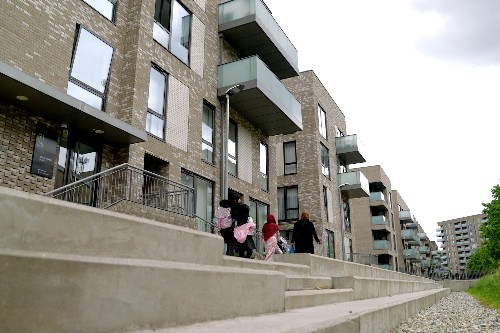
Image shows one of the filming locations at a housing development in Tower Hamlets, London.Beeston Media
Expert voices from planning, health, government and consultants have shared their insights of using Health Impact Assessments as a force for good to create healthier new communities.
In a series of eight films from the TRUUD research programme, participants look at their own experiences of embedding requirements for Health Impact Assessments (HIAs) in their local plans and share where they've seen positive impacts and what could be improved.
Based at the University of Bristol, and with researchers across six different universities, TRUUD (Tackling the Root causes Upstream of Unhealthy Urban Development) is a £10 million research project, looking at how urban places can be planned to reduce non-communicable diseases such as cancers, diabetes, obesity, mental ill-health and respiratory illness.
Although there is no national requirement for HIAs in this context, many local authorities require them to be undertaken as part of applications for development. HIAs can include consideration of issues such as local availability of healthy food, indoor space for family or communal dining, safe spaces for play and measures to mitigate climate change.
TRUUD research identified that just 38% of local plans have an HIA policy and that officers from across planning practice were looking for examples of their use and guidance from their peers.
Contributions to the films highlight:
- Creating usable green spaces rather than a 'tick-box' approach;
- Building confidence and buy-in between developers and planners;
- Future-proofing communities for generational living;
- Team working between public health and planning and getting senior-level buy-in to a health approach;
- Using HIAs to avoid technical language; and
- Using HIAs to promote better community engagement.
Senior Law Lecturer at the University of Bristol Dr Ed Kirton-Darling is part of the law intervention team at TRUUD. He said: "During our research we came across many stories of HIAs being little more than a tick-box exercise, a hoop to be jumped through with little attention in the process being given to wider questions of health for the community.
"We know that the main goal of an HIA should be a force for good to maximise the potential health benefits of a development. These films bring together a range of insights and advice to help develop best practice in the use of HIA in relation to planning."
The films include contributions from officers at Darlington, Doncaster, Luton, Tower Hamlets and Wakefield councils; planning consultants at Iceni Projects and RPS Group; and the Office for Health Improvement and Disparities and the Local Government Association.
Cllr David Fothergill, Chair of the LGA Community Wellbeing Board added: "Health Impact Assessments are invaluable in guiding our urban planning to promote health and wellbeing for communities. By systematically evaluating the potential health effects of policies and projects, we can identify and mitigate risks, enhance benefits and address inequalities. This approach ensures that our decisions today build healthier, more inclusive communities for the future."
In a new blog for TRUUD, Dr Ed Kirton-Darling explains more of his team's background and analysis of local plans and HIAs, including seven tips for more successful policies.






